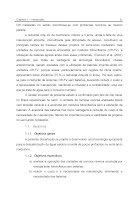







UNIDADE DE OSMOSE REVERSA ACIONADA POR ENERGIA SOLAR
FOTOVOLTAICA SEM BATERIAS:
Simulação, Projeto e Validação Experimental
FORTALEZA 2005-CEARA-BRASIL
Dissertação submetida à
Universidade Federal do Ceará
como parte dos requisitos para a
obtenção do grau de Mestre em Engenharia Elétrica.
DOUGLAS BRESSAN RIFFEL
ABSTRACT
RIFFEL, D.B.; 2005. Photovoltaic-powered Reverse Osmosis Plant without
Batteries: Simulation, Design and Experimental Validation. Fortaleza. Thesis
(Master degree) – Centro de Tecnologia, Universidade Federal do Ceará.125p.
This research analyzes the combination of photovoltaic generation with
reverse osmosis desalination of brackish water for the supply of dinking water.
Access to potable water and electric power is still an unresolved problem for many
people around the world. The State of Ceará, where this research was carried out,
represents well this reality. A photovoltaic-powered reverse osmosis plant was
installed in laboratory. Through the elimination of the battery, investment costs and
maintenance need could be reduced. At the same time, this changes completely
the operation of the unit, being totally subordinate to the instantaneous conditions
of solar radiation and temperature. A plant design procedure was elaborated that
uses solar radiation statistical data and the seasonal availability of water from
cisterns as design parameters. Two systems were mathematically modeled and
validated by experiment. System 1 uses a motor-pump directly coupled to two 55
Wp photovoltaic modules. System 2 disposes of one additional module and a DCDC
buck converter with maximum power point tracking between the photovoltaic
array and the load. The necessity to regulate the power transferred to the load in
System 2, led to the development of the converter and the tracking algorithm
specially for this application. The simulations allowed the comparison between the
two systems in two conditions: with and without a pressure relief valve coupled to
system 1. Results shown that the System 2 has always a better performance, as a
daily permeate water production, time operation, specific consumption and in the
relationship photovoltaic installed capacity per produced water liter. It was
observed that volumetric pumps, of the diaphragm type in the case, are suitable
for reverse osmosis applications. But, when combined with a photovoltaic array,
maximum power point tracking is necessary. It is important to state that with a
50 % increment in generation capacity a 90% increase in permeate production is
achieved.
Key-words: photovoltaic generation, reverse osmosis, brackish water desalination,
solar energy.

































 JOSIL ARTISTA PLASTICO FORTALEZA CEARA BRASIL AV.HERACLITO GRAÇA 41 TEL(85)32542378
JOSIL ARTISTA PLASTICO FORTALEZA CEARA BRASIL AV.HERACLITO GRAÇA 41 TEL(85)32542378
















Nenhum comentário:
Postar um comentário